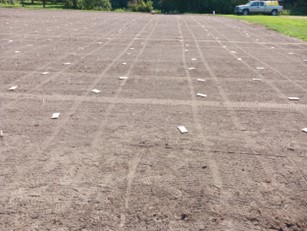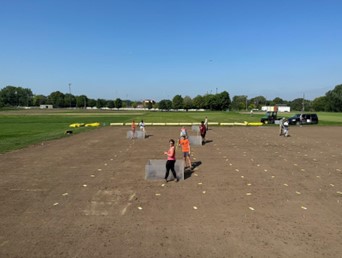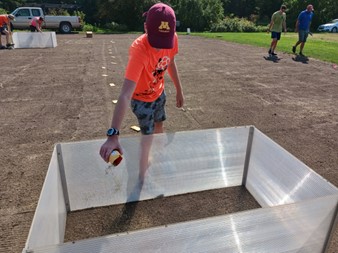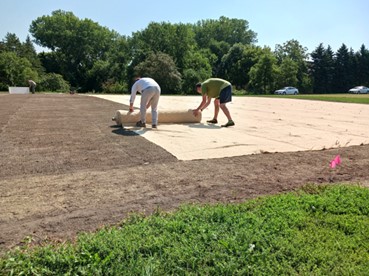By Kim Tiber
How do we seed all those perfect side-by-side rectangle plots of different turfgrass cultivars? In the first few months in my position as Field Facility Manager, I’ve been wondering that myself. Earlier this week I was able to participate in the process of seeding some of those plots. In this case we were seeding a Fine Fescue Cooperative Turfgrass Breeder Test (CTBT). The field where the trial was being planted had previously been sprayed and killed so we were starting with a vacant field. The field was tilled, packed and raked to remove debris. A tape measure and string lines are used to lay out the individual cultivar plots and plot corners are marked with small wood stakes. Tenacity herbicide for preemergence and postemergence weed control and a starter fertilizer were applied just prior to seeding. Individual envelopes of premeasured seed of the different cultivars are laid out on the plots and seeding is ready to begin (Figure 1).

This is where the team effort really begins. On this day we had four seeding frames in use so we had four teams of two people putting down seed (Figure 2).

Each team lines up a frame on the marked plot. One team member opens the seed envelope and sprinkles the seed over the plot (Figure 3) and then both team members pick up the frame and move it to the next plot. While one team member sprinkles seed on the new plot the second team member lightly rakes the seed on the plot that was already planted and they work their way across the row with this routine.

After the seeding teams have completed several rows other team members begin rolling out and staking down Futerra blankets to keep soil and seed in place and retain moisture during germination (Figure 4).

With a whole team working together we can cover a lot of ground in a short period of time. In this case seeding was completed in about two hours. All that’s left to do is set and adjust irrigation as needed, monitor the site for germination and wait for those perfect rectangles to appear. Thank you to everyone who came out to help with seeding on one of the hottest days of the summer!